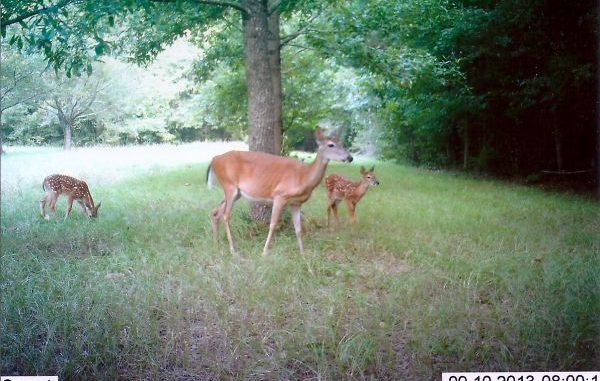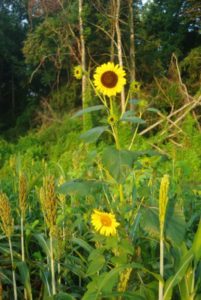
It’s not all about hunting
The first shots of the 2013 season were fired on Sept. 7 when the dove season opened, but my efforts to make some dove sites for us to hunt proved fruitless.
But, despite the fact that we did not kill a dove or even fire a single shot, I believe my time and effort spent with the habitat work was well worth the time and money. In fact, I have been making dove patches for the past three years, and we haven’t killed a single dove.
Now, some would probably say I should just quit and not worry about it, but when I consider all the species of wildlife that do benefit from the work, I am going to keep doing it.
Every fall I plant three or four sites with turnips and mustards, mixing in some winter grass and clover. These sites provide deer with some high-quality forage in addition to the greens and turnips they provide for family and friends.
We do have feral hogs running around, but they must not eat turnips because they never root them up.
In February, we harvest the turnips and donate the crop to the Greater Baton Rouge Food Bank.
Once harvested, these sites are plowed up and planted with vegetation that produces seed for birds, with doves being the target species. Of course, the sites will also benefit the wild turkeys that frequent our property. I would like to say that it benefits Mr. Bobwhite, but to date no quail have showed up on the property.
This past spring I planted sunflowers and super sorghum at several sites. At another site I planted sunflowers and Mississippi purple hull peas. The sunflowers and sorghum did great; I wasn’t sure about the peas, but while on the tractor one day I noticed some purple color in the patch and discovered the peas had produced a pretty good crop and provided us with peas for the pot and the freezer.
My daughter, who lives on the property with her husband and boys, had fresh sunflowers on the kitchen table for several weeks. A patch of sunflowers really enhances the looks of the property when they are in full bloom.
I also noticed that, for some reason, there was an abundant crop of barnyard millet mixed in with the sunflowers and sorghum; this grass produces a really nice seed for birds.

The plantings benefited from the frequent rains during this past growing season, and I was pleased with my efforts.
In August I began to clip the sites, and by the middle of the month there were several dozen doves feeding on the property. As the dove season approached, however, I noticed fewer doves so I kept clipping the grassy sites around these patches hoping that might help hold doves.
In Louisiana it is legal to plant wheat beginning Sept. 1, so before the season opened on the Sept. 7 I plowed the sites and planted wheat and the turnips and mustards.
On opening day of the dove season, I got up early to watch if any doves were going to fly in and feed that morning. I saw about four doves. Needless to say the nine-day dove season was a bust for us.
Again, some would say I am wasting my time and money trying to attract doves. The fact is doves did benefit from the effort — we just did not put any in the game bag.
But when you start considering what other wildlife species are benefiting from these sites — and I am talking about the whole gamut of critters that occupy the forests and fields on our property — it was well worth the effort.
This is the way it is with most of the habitat work done for wildlife: It is the non-target species that often benefit more than the target species, those that we pursue during the hunting seasons.
And this is exactly why hunting is so important: The work done to benefit the game animals and birds benefits all species of wildlife, and hunters do not mind this one bit. They are more than willing to continue spending money to create and enhance wildlife habitat for all species.
I don’t think you will see non-hunters willing to spend their money on habitat work. Why should they? Hunters have been footing the bill for much of the wildlife habitat work in this country for years. A good example of this is the Sherburne South Farm: This area is managed primarily for waterfowl and waterfowl hunting, but the various management units provide habitat for so many other species of animals and birds, including bald eagles, swallowtail kites, wood storks, herons, egrets, purple gallinules, songbirds, deer, beaver, rabbits, coyotes, rats, mice, snakes and crawfish — and the list goes on and on.
On our property, the dove sites are providing habitat for a whole host of songbirds. I would say that bluebirds and the wild turkey are our two signature birds, and I see them all the time. Bluebirds use the nest boxes we have up around the sites, and they are all the time flying down and picking insects up. I also like to see the buntings, cardinals and towhees feeding in these sites.
While we do not think too often of the insect world, the fact is that my dove sites are loaded with these six-legged creatures. I am amazed when I get up early and walk around the sunflowers and see the bumblebees that are attached to the sunflower heads. When clipping these sites I always have fun watching the field rats and mice scurrying away from the tractor. On one occasion this year I noticed a black snake with a mouse in its mouth, carefully avoiding the tractor while holding on to its meal. I saw it several times so I finally just left an uncut strip for it to hang around in and enjoy the meal.
Perhaps if we considered these non-target critters more often with our management work, we could eliminate some of our wildlife problems. Coyotes would have more rats, mice and rabbits to feed on, and perhaps they would leave the whitetails alone.
In no way am I discouraged, and I am not going to stop planting the upland sites. In fact, I am making plans on how I can increase my efforts and perhaps actually fire a shot at a dove one day.
August and September were exceptionally hot months, and it looked like Mother Nature had turned the faucet off, but the rain finally fell (even in Tiger Stadium against Auburn). The turnip patches got some much-needed rain, and prior to the rain event I finished planting my other deer and turkey winter sites.
This year I planted mixes of clovers, chickory and wheat; I also had some clover sites that I just cut and fertilized with the idea that they will regenerate with clover again.
My spring deer patches of joint-vetch and cowpeas also benefited from the rain event, and I am hoping I will have a few deer stories to share with you as the season progresses.
We will again benefit from the long-term habitat work of tree planting. The sawtooth oaks have acorns again, and I am hoping these trees will provide me with some crossbow hunting. The white oaks and water oaks also have acorns, and deer should not be lacking for food in the woods this season.
The fawn crop looks very good, and perhaps the excellent growing-season rains have had a positive impact on the habitat and herds across the state. Healthy habitat produces healthy and fat deer, and fat deer keeps us hunters happy.
So the next time you come home with an empty game bag and think you might be wasting your time and money with the management work that you are doing, think about the other critters that are flying, creeping and walking around.
I think you will see you are probably doing a whole lot of good.


